Erhan Karakoca
Design and Evaluation of Neural Network-Based Receiver Architectures for Reliable Communication
Mar 26, 2025

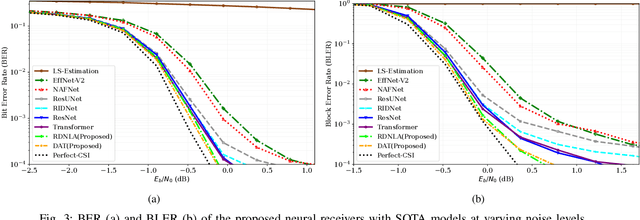
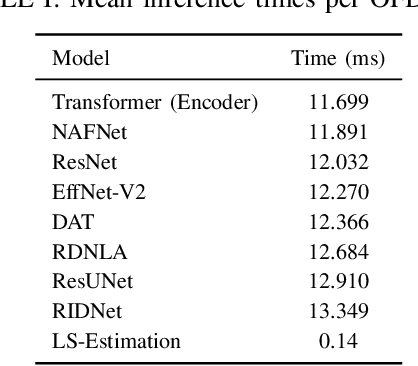
Abstract:Neural network-based receivers leverage deep learning to optimize signal detection and decoding, significantly improving bit-error rate (BER) and block-error rate (BLER) in challenging environments. This study evaluates various architectures and compares their BER and BLER performance across different noise levels. Two novel models, the Dual Attention Transformer (DAT) and the Residual Dual Non-Local Attention Network (RDNLA), integrate self-attention and residual learning to enhance signal reconstruction. These models bypass conventional channel estimation and equalization by directly predicting log-likelihood ratios (LLRs) from received signals, with noise variance as an additional input. Simulations show that DAT and RDNLA outperform traditional and other neural receiver models under varying signal-to-noise ratios (SNR), while their computational efficiency supports their feasibility for next-generation communication systems.
RIS Optimization Algorithms for Urban Wireless Scenarios in Sionna RT
Jan 10, 2025Abstract:This paper evaluates the performance of reconfigurable intelligent surface (RIS) optimization algorithms, which utilize channel estimation methods, in ray tracing (RT) simulations within urban digital twin environments. Beyond Sionna's native capabilities, we implement and benchmark additional RIS optimization algorithms based on channel estimation, enabling an evaluation of RIS strategies under various deployment conditions. Coverage maps for RIS-assisted communication systems are generated through the integration of Sionna's RT simulations. Moreover, real-world experimentation underscores the necessity of validating algorithms in near-realistic simulation environments, as minor variations in measurement setups can significantly affect performance.
Channel Estimation Using RIDNet Assisted OMP for Hybrid-field THz Massive MIMO Systems
Aug 31, 2023Abstract:The terahertz (THz) band radio access with larger available bandwidth is anticipated to provide higher capacities for next-generation wireless communication systems. However, higher path loss at THz frequencies significantly limits the wireless communication range. Massive multiple-input multiple-output (mMIMO) is an attractive technology to increase the Rayleigh distance by generating higher gain beams using low wavelength and highly directive antenna array aperture. In addition, both far-field and near-field components of the antenna system should be considered for modelling THz electromagnetic propagation, where the channel estimation for this environment becomes a challenging task. This paper proposes a novel channel estimation method using a recursive information distillation network (RIDNet) together with orthogonal matching pursuit (OMP) for hybrid-field THz mMIMO channels, including both far-field and near-field components. The simulation experiments are performed using the ray-tracing tool. The results indicate that the proposed RIDNet-based method consistently provides lower channel estimation errors compared to the conventional OMP algorithm for all signal-to-noise ratio (SNR) regimes, and the performance gap becomes higher at low SNR regimes. Furthermore, the results imply that the same error performance of the OMP can be achieved by the RIDNet-based method using a lower number of RF chains and pilot symbols.
RIDNet Assisted cGAN Based Channel Estimation for One Bit ADC mmWave MIMO Systems
Jun 15, 2023Abstract:The estimation of millimeter wave (mmWave) massive multiple input multiple output (MIMO) channels becomes compelling when one-bit analog to digital converters (ADCs) are utilized. Furthermore, as the number of antenna increases, pilot overhead scales up to provide consistent channel estimation, eventually degrading spectral efficiency. This study presents a channel estimation approach that combines a conditional generative adversarial network (cGAN) with a novel blind denoising network with a sparse feature attention mechanism. Performance analysis and simulations show that using a cGAN fused with a feature attention-based denoising neural network significantly enhances the channel estimation performance while requiring less pilot transmission.
Measurement-Based Modeling of Short Range Terahertz Channels and Their Capacity Analysis
Jun 14, 2023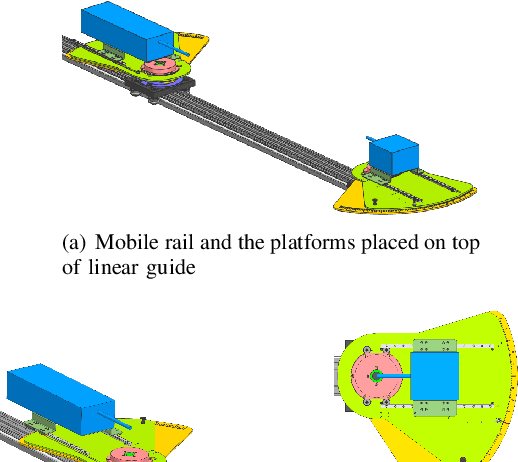
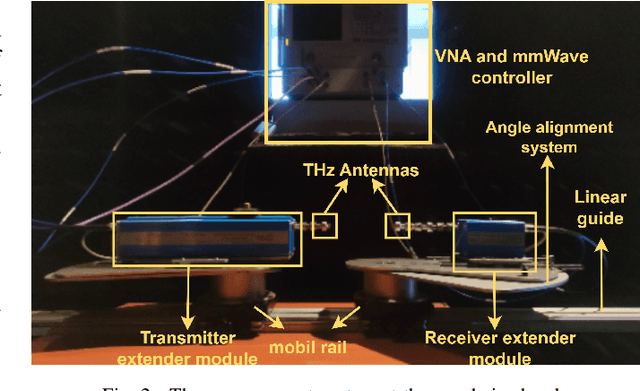
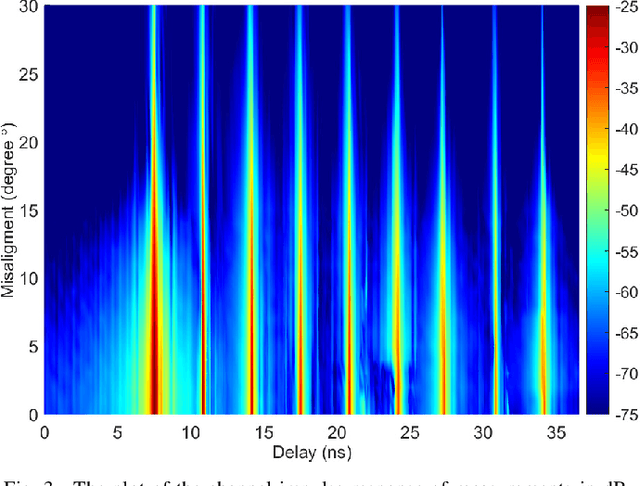
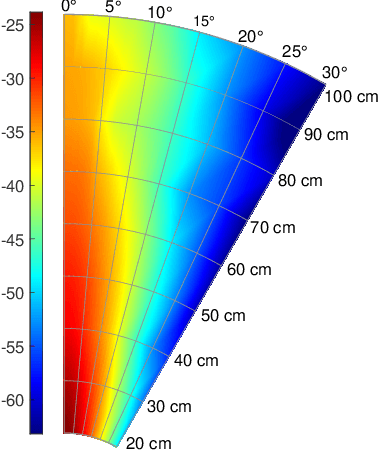
Abstract:In this work, extensive propagation characteristics of short range 240 to 300 GHz terahertz (THz) channels are mapped based on a measurement campaign conducted utilizing a novel, task specific measurement system. The measurement system allows collecting measurements from different distances and orientations in a very fine grained resolution, which is a particular issue in achieving realistic THz channel estimation. After the accurate measurement results are obtained, they are investigated in terms of channel impulse and channel frequency response. Furthermore, the fading channel amplitude histograms are modeled with the Gamma mixture model (GMM). The expectation-maximization (EM) algorithm is utilized to determine the corresponding mixture parameters. Also, to demonstrate the flexibility of the GMM, the Dirichlet process Gamma mixture model (DPGMM) is utilized in cases where the EM algorithm fails to represent histograms. Moreover, the suitability of the GMM is evaluated utilizing Kolmogorov Smirnov tests. Results verify that the GMMs can simulate the fading channel of micro-scale THz wireless communication in a realistic way, providing important implications regarding the achievable capacity in these channels. Finally, the average channel capacity of each link is evaluated using the probability density function of GMMs to gain deeper insight into the potential of micro-scale THz communications.
Experimental Assessment of Misalignment Effects in Terahertz Communications
May 23, 2023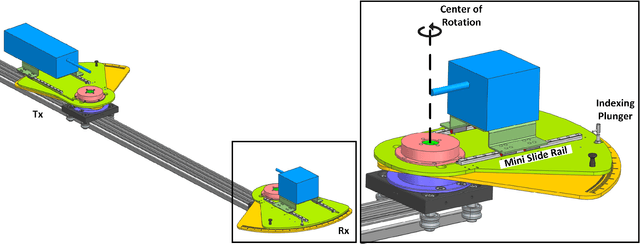
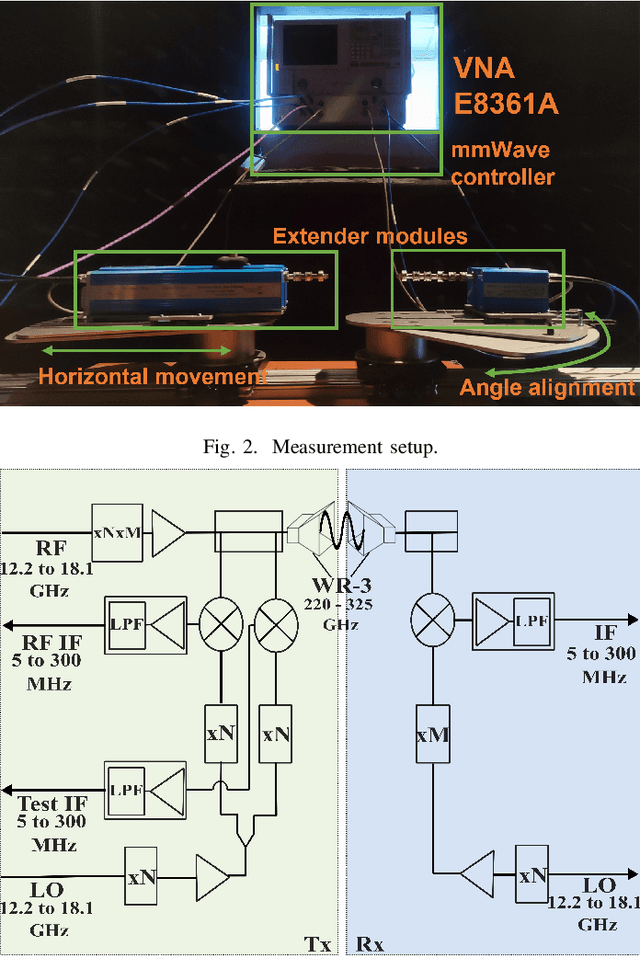
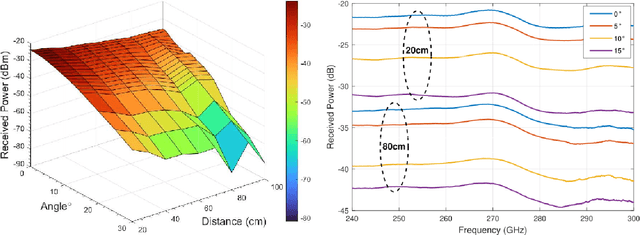
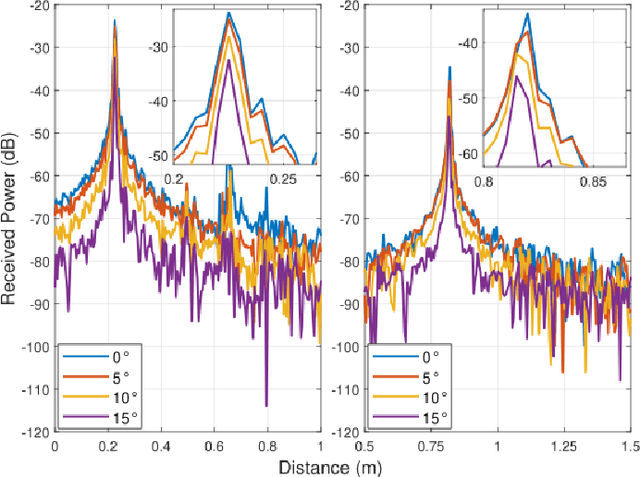
Abstract:Terahertz (THz) frequencies are important for next generation wireless systems due to the advantages in terms of large available bandwidths. On the other hand, the limited range due to high attenuation in these frequencies can be overcome via densely installed heterogeneous networks also utilizing UAVs in a three-dimensional hyperspace. Yet, THz communications rely on precise beam alignment, if not handled properly results in low signal strength at the receiver which impacts THz signals more than conventional ones. This work focuses on the importance of precise alignment in THz communication systems and the significant effect of proper alignment is validated through comprehensive measurements conducted through a state-of-the-art measurement setup, which enables accurate data collection between 240 GHz to 300 GHz at varying angles and distances in an anechoic chamber eliminating reflections. By analyzing the channel frequency and impulse responses of these extensive and particular measurements, this study provides the first quantifiable results in terms of measuring the effects of beam misalignment in THz frequencies.
Hierarchical Dirichlet Process Based Gamma Mixture Modelling for Terahertz Band Wireless Communication Channels
May 08, 2022



Abstract:Due to the unique channel characteristics of Terahertz (THz), comprehensive propagation channel modeling is essential to understand the spectrum and to develop reliable communication systems in these bands. Ray tracing and traditional statistical modeling are insufficient to construct a suitable channel model due to the wide bandwidth and rapid changes in the characteristics of THz channels. In this work, we propose the utilization of hierarchical Dirichlet Process Gamma Mixture Model (DPGMM) to characterize THz channels statistically in the absence of any prior knowledge. DPGMM provides mixture component parameters and the required number of components. A revised expectation-maximization (EM) algorithm is also proposed as a pre-step for DPGMM. Kullback-Leibler Divergence (KL-divergence) is utilized as an error metric to examine the amount of inaccuracy of the EM algorithm and DPGMM when modeling the experimental probability density functions (PDFs). DPGMM and EM algorithm are implemented over the measurements taken at frequencies between 240 GHz and 300 GHz. By comparing the results of the DPGMM and EM algorithms for the measurement datasets, we demonstrate how well the DPGMM fits the target distribution. It is shown that the proposed DPGMM can accurately describe the various THz channels as good as the EM algorithm, and its flexibility allows it to represent more complex distributions better than the EM algorithm. We also demonstrated that DPGMM can be used to model any wireless channel due to its versatility.
 Add to Chrome
Add to Chrome Add to Firefox
Add to Firefox Add to Edge
Add to Edge